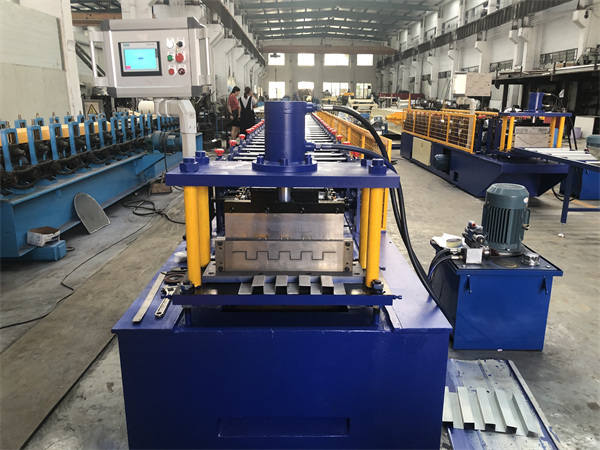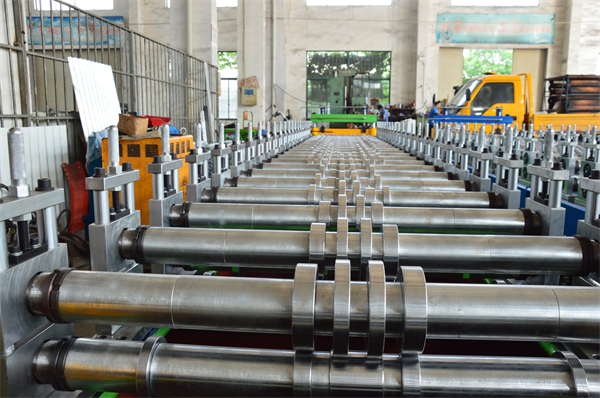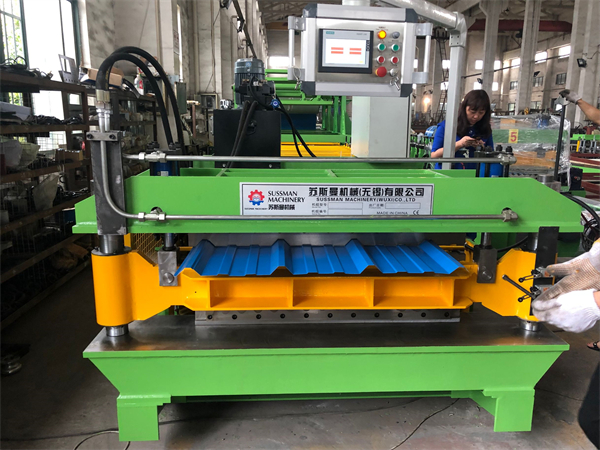1. Introduction
In the world of modern manufacturing, efficiency and precision play a vital role in meeting the ever-growing demands of various industries. One such technological marvel that has revolutionized the production process is the C Section Roll Forming Machine. This article dives deep into the workings, benefits, applications, and much more, surrounding the C Section Roll Forming Machine.
2. What is a C Section Roll Forming Machine?
A C Section Roll Forming Machine is an advanced manufacturing equipment used to shape metal strips into C-shaped profiles, also known as C channels. These channels are widely used in the construction, automotive, furniture, and electrical industries, among others. The machine’s ability to form uniform and precise profiles makes it a popular choice for mass production.
3. How Does a C Section Roll Forming Machine Work?
The C Section Roll Forming Machine operates on a continuous process. Metal coils are fed into the machine, where a series of rollers gradually bend the strip into the desired C-shaped profile. The process involves multiple stations, each contributing to the final shape of the channel. The machine’s computer-controlled precision ensures consistent output with minimal waste.

4. Advantages of Using C Section Roll Forming Machines
The utilization of C Section Roll Forming Machines offers numerous advantages to manufacturers:
- High Efficiency: The continuous forming process allows for rapid production, reducing manufacturing time and meeting tight deadlines.
- Cost-Effective: Once the initial tooling is set up, the cost per unit decreases, making it cost-effective for large-scale production.
- Precision and Consistency: C Section Roll Forming Machines produce consistent profiles with high accuracy, minimizing deviations and waste.
- Material Savings: The efficient use of materials and the ability to work with thinner gauges help in material savings.
- Versatility: These machines can handle various materials, including steel, aluminum, and other alloys, offering versatility in production.
5. Types of C Section Roll Forming Machines
There are different types of C Section Roll Forming Machines designed to cater to specific manufacturing needs. Some common types include:
5.1 Single Station C Section Roll Forming Machine
The single station C Section Roll Forming Machine is a compact and cost-efficient option suitable for smaller production volumes and simpler profiles.
5.2 Double Station C Section Roll Forming Machine
The double station C Section Roll Forming Machine increases productivity by having two workstations, allowing simultaneous forming of two profiles.
5.3 High-Speed C Section Roll Forming Machine
The high-speed C Section Roll Forming Machine is equipped with advanced automation and high-speed capabilities for large-scale production requirements.
6. Factors to Consider When Choosing a C Section Roll Forming Machine
Selecting the right C Section Roll Forming Machine for your manufacturing needs requires careful consideration of several factors:
6.1 Material Compatibility
Ensure that the machine can handle the specific material you intend to work with, considering thickness and strength.
6.2 Production Speed
The production speed should align with your production targets and overall efficiency goals.
6.3 Customization Options
Look for machines that offer customization features to cater to unique profile requirements.
6.4 Durability and Reliability
Invest in a machine known for its durability and reliability to ensure long-term productivity.
6.5 Cost and Budget
Find a balance between the machine’s capabilities and your budget constraints.

7. Proper Maintenance and Safety Tips for C Section Roll Forming Machines
Maintaining a C Section Roll Forming Machine is crucial for its longevity and consistent performance. Additionally, following safety guidelines ensures the well-being of machine operators:
7.1 Regular Maintenance Procedures
Implement a regular maintenance schedule to inspect, clean, and lubricate the machine components.
7.2 Safety Guidelines for Operators
Train operators on safe machine operation, the proper use of personal protective equipment, and emergency protocols.
8. Common Quality Issues and Troubleshooting
Despite the precision of C Section Roll Forming Machines, some issues may arise during the production process:
8.1 Uneven Forming
Identify and rectify the factors causing uneven forming to ensure consistent quality.
8.2 Material Warping
Address material warping issues caused by temperature variations or improper handling.
8.3 Jamming and Blockage
Develop procedures to handle instances of jamming and blockage promptly to minimize downtime.
9. Applications of C Section Roll Forming Machines
C Section Roll Forming Machines find applications in various industries:
9.1 Construction Industry
Used for manufacturing roof trusses, wall studs, and other structural components.
9.2 Automotive Industry
Utilized in creating automotive chassis components and body frames.
9.3 Furniture Manufacturing
Involved in producing metal furniture frames and shelving systems.
9.4 Electrical and Electronics Industry
Employed in manufacturing electrical enclosures and support structures for electronic devices.

10. Trends and Innovations in C Section Roll Forming Technology
10.1 Automation and Integration
Manufacturers are increasingly integrating C Section Roll Forming Machines into automated production lines. Automation streamlines the process, reduces manual intervention, and boosts overall productivity. Integrated systems allow seamless communication between different machinery, leading to better control and synchronization.
10.2 Industry 4.0 and IoT Integration
Industry 4.0 principles and the Internet of Things (IoT) are revolutionizing the manufacturing landscape. C Section Roll Forming Machines are being equipped with smart sensors and data analytics capabilities. Real-time data monitoring allows for predictive maintenance, optimizing machine performance, and reducing downtime.
10.3 Advanced Material Handling
Incorporating sophisticated material handling systems has become a focus in modern C Section Roll Forming Machines. Automated coil loading and unloading mechanisms improve efficiency and reduce manual labor requirements.
11. Environmental Impact and Sustainability of C Section Roll Forming Machines
As the world moves towards more sustainable practices, the environmental impact of manufacturing processes becomes crucial. C Section Roll Forming Machines contribute positively to sustainability:
11.1 Material Savings
The efficient use of materials reduces waste and promotes resource conservation.
11.2 Energy Efficiency
Modern C Section Roll Forming Machines are designed with energy-saving features, reducing overall energy consumption.
11.3 Recyclability
C Section profiles made using these machines are often recyclable, further promoting a circular economy.
12. Comparing C Section Roll Forming Machines with Other Roll Forming Methods
While C Section Roll Forming Machines are highly versatile, it’s essential to understand how they compare to other roll forming methods:
12.1 C Section vs. U Channel Roll Forming
C and U channels share some similarities, but they differ in shape. U channels have flanges on both sides, while C channels have flanges on one side. Manufacturers choose between them based on specific application needs.
12.2 C Section vs. Hat Channel Roll Forming
Hat channels, also known as furring channels, have two flanges on the top and bottom. They are often used to attach building materials like drywall. C Section Roll Forming Machines are better suited for producing C channels with a single flange.
12.3 C Section vs. Z Section Roll Forming
Z sections have two flanges that are parallel to each other, creating a Z shape. These profiles are commonly used as purlins in roof construction. The choice between C and Z sections depends on the application’s load-bearing requirements.
14. Case Studies: Real-Life Applications of C Section Roll Forming Machines
14.1 Project X: Building Construction
In Project X, a construction company utilized C Section Roll Forming Machines to manufacture high-quality steel studs and tracks for constructing durable and fire-resistant wall systems. The efficiency of the machines allowed the company to meet tight construction deadlines.
14.2 Project Y: Automotive Component Manufacturing
Project Y involved the production of automotive chassis components using C Section Roll Forming Machines. The machines’ precision ensured that each component met the required tolerances, ensuring safety and performance in vehicles.
14.3 Project Z: Solar Panel Support Structures
For Project Z, a solar panel manufacturer used C Section Roll Forming Machines to create custom support structures. The ability to produce profiles with varying dimensions and thicknesses enabled efficient solar panel installation.
15. Future Prospects of C Section Roll Forming Machines
The future of C Section Roll Forming Machines looks promising, with ongoing technological advancements and increasing demand across various industries. The incorporation of AI, machine learning, and further automation will enhance productivity and reduce production costs.

Conclusion
C Section Roll Forming Machines have emerged as a game-changer in the manufacturing world. Their precision, efficiency, and versatility make them indispensable for a wide range of applications. As the industry embraces sustainability and advanced technologies, these machines will continue to play a pivotal role in shaping the future of manufacturing.
FAQs
- Q: Are C Section Roll Forming Machines suitable for high-volume production?
- A: Yes, C Section Roll Forming Machines are ideal for high-volume production due to their continuous and rapid forming process.
- Q: Can C Section Roll Forming Machines handle different types of metals?
- A: Yes, C Section Roll Forming Machines can work with various metals, including steel, aluminum, and alloys.
- Q: What are the primary safety considerations when operating these machines?
- A: Operators should be trained on safe machine operation, use appropriate personal protective equipment, and adhere to emergency protocols.
- Q: How do C Section Roll Forming Machines contribute to sustainability?
- A: C Section Roll Forming Machines promote sustainability through material savings, energy efficiency, and recyclability of the produced profiles.
- Q: What role will automation play in the future of C Section Roll Forming Machines?
- A: Automation will play a significant role, leading to increased productivity, reduced labor requirements, and enhanced data analytics for predictive maintenance.
